Countdown to discovery! Not since Voyager 2’s flyby of Neptune in 1989 have we flung a probe into the frozen outskirts of the Solar System. Speeding along at 30,800 miles per hour New Horizons will pierce the Pluto system like a smartly aimed arrow.
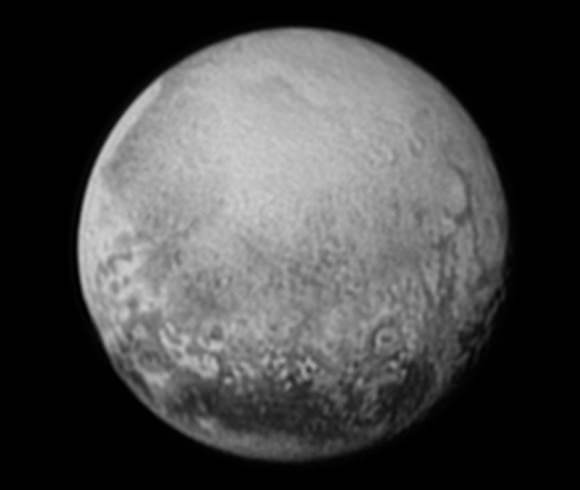
Credits: NASA/JHUAPL/SWRI
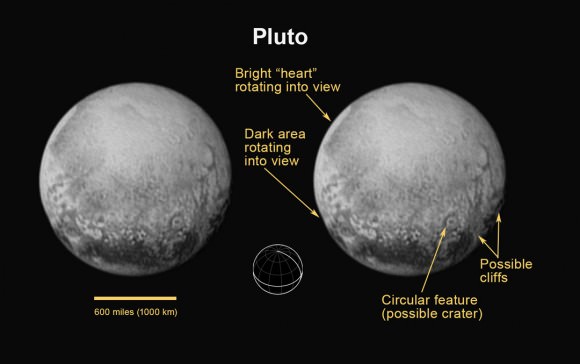
Credits: NASA/JHUAPL/SWRI
Edging within 7,800 miles of its surface at 7:49 a.m. EDT, the spacecraft’s long-range telescopic camera will resolve features as small as 230 feet (70 meters). Fourteen minutes later, it will zip within 17,930 miles of Charon as well as image Pluto’s four smaller satellites — Hydra, Styx, Nix and Kerberos.
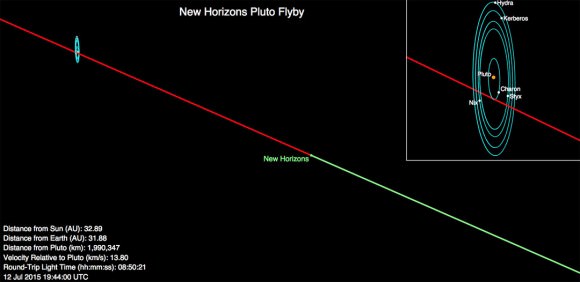
After zooming past, the craft will turn to photograph Pluto eclipsing the Sun as it looks for the faint glow of rings or dust sheets illuminated by backlight. At the same time, sunlight reflecting off Charon will faintly illuminate Pluto’s backside. What could be more romantic than Charonshine?
Six other science instruments will build thermal maps of the Pluto-Charon pair, measure the composition of the surface and atmosphere and observe Pluto’s interaction with the solar wind. All of this will happen autopilot. It has to. There’s just no time to send a change instructions because of the nearly 9-hour lag in round-trip communications between Earth and probe.
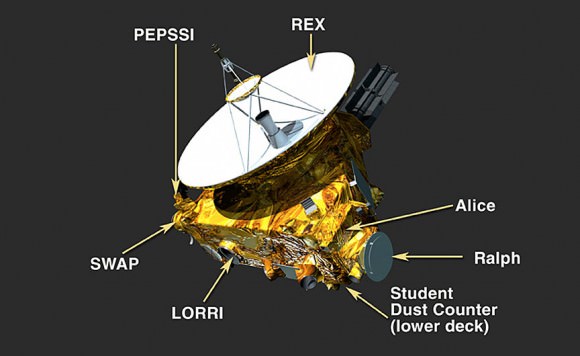
Want to go along for the ride? Download and install NASA’s interactive app Eyes on Pluto and then click the launch button on the website. You’ll be shown several options including a live view and preview. Click preview and sit back to watch the next few days of the mission unfold before your eyes.
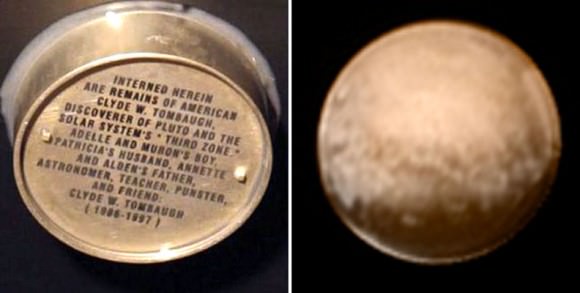
Like me, you’ve probably wondered how daylight on Pluto compares to that on Earth. From 3 billion miles away, the Sun’s too small to see as a disk with the naked eye but still wildly bright. With NASA’s Pluto Time, select your city on an interactive map and get the time of day when the two are equal. For my city, daylight on Pluto equals the gentle light of early evening twilight six minutes after sunset. An ideal time for walking, but step lightly. In Pluto’s gentle gravity, you only weigh 1/15 as much as on Earth.
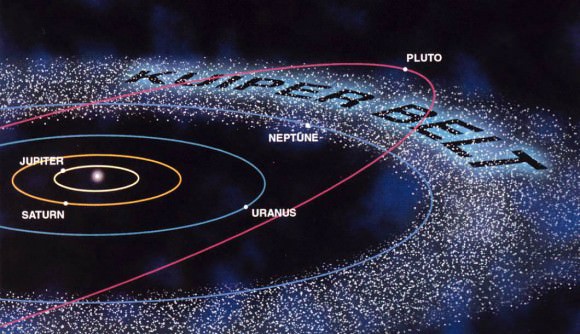
New Horizons is the first mission to the Kuiper Belt, a gigantic zone of icy bodies and mysterious small objects orbiting beyond Neptune. This region also is known as the “third” zone of our solar system, beyond the inner rocky planets and outer gas giants. Pluto is its most famous member, though not necessarily the largest. Eris, first observed in 2003, is nearly identical in size. It’s estimated there are hundreds of thousands of icy asteroids larger than 61 miles (100 km) across along with a trillion comets in the Belt, which begins at 30 a.u. (30 times Earth’s distance from the Sun) and reaches to 55 a.u.
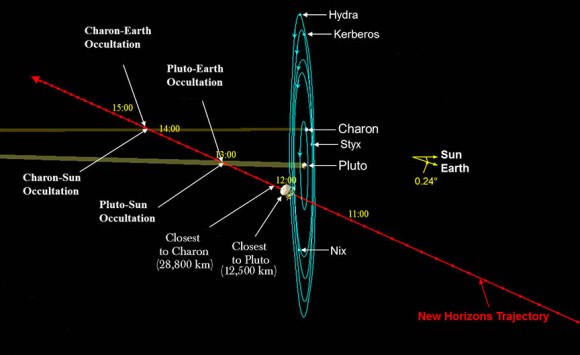
Below you’ll find a schedule of events in Eastern Time. (Subtract one hour for Central, 2 hours for Mountain and 3 hours for Pacific). Keep in mind the probe will be busy shooting photos and gathering data during the flyby, so we’ll have to wait until Wednesday July 15 to see the the detailed close ups of Pluto and its moons. Even then, New Horizons’ recorders will be so jammed with data and images, it’ll take months to beam it all back to Earth.
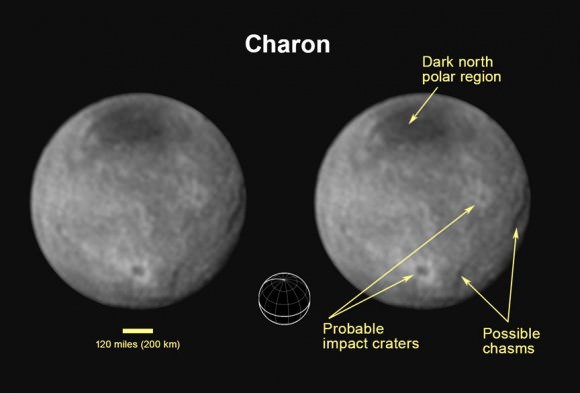
Credits: NASA/JHUAPL/SWRI
Fasten your seat belts — we’re in for an exciting ride.
We’ll be reporting on results and sharing photos from the flyby here at Universe Today, but you’ll also want to check out NASA’s live coverage on NASA TV, its website and social media.
Monday, July 13
10:30 a.m. to noon – Media briefing on mission status and what to expect broadcast live on NASA TV
Tuesday, July 14
7:30 to 8 a.m. – Arrival at Pluto! Countdown program on NASA TV
At approximately 7:49 a.m., New Horizons is scheduled to be as close as the spacecraft will get to Pluto, approximately 7,800 miles (12,500 km) above the surface, after a journey of more than 9 years and 3 billion miles. For much of the day, New Horizons will be out of communication with mission control as it gathers data about Pluto and its moons.
The moment of closest approach will be marked during a live NASA TV broadcast that includes a countdown and discussion of what’s expected next as New Horizons makes its way past Pluto and potentially dangerous debris.
8 to 9 a.m. – Media briefing, image release on NASA TV
Wednesday, July 15
3 to 4 p.m. – Media Briefing: Seeing Pluto in a New Light; live on NASA TV and release of close-up images of Pluto’s surface and moons, along with initial science team reactions.
We’ll have the latest Pluto photos for you, but you can also check these excellent sites:
* Long Range Reconnaissance Imager (LORRI) archive
* Pluto Photojournal
* New Horizons science photo gallery
Need more Pluto? Spend a few minutes watching this excellent New York Times mission documentary.

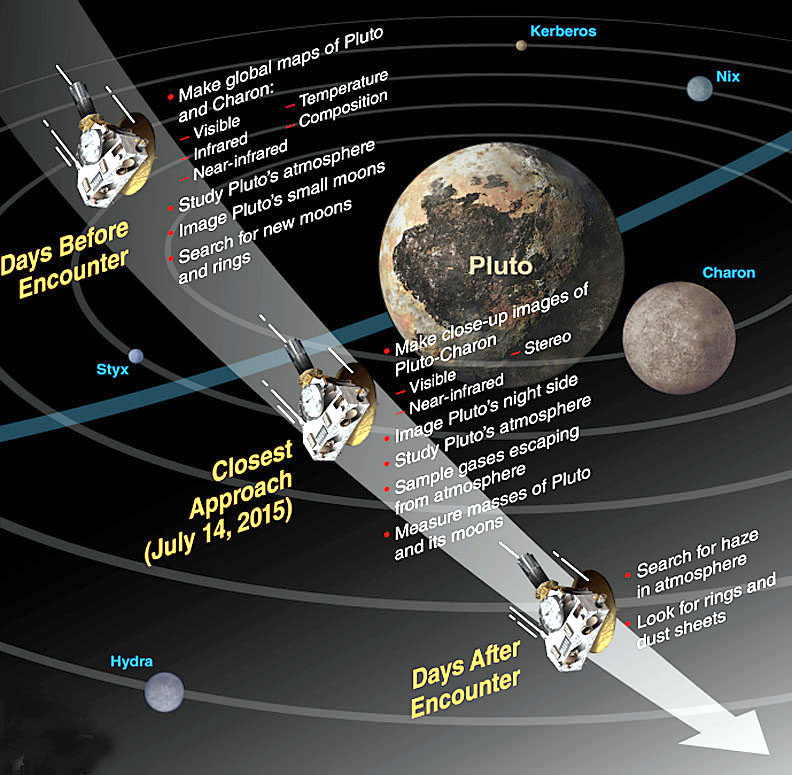
The daily briefing on NASATV was moved ahead a half hour to 10:30am eastern time.
http://www.nasa.gov/press-release/nasa-pluto-new-horizons-july-13-media-briefing-time-change-media-center-open/
Thanks Steven for the update. I’ll update the time.
There is a typo on one of the image captions which says Pluto discovered 1903 – It should read 1930.
Great article thanks for the timeline and wonderful articles.. You UT writers dont hear that enough I guess..
Weasel, That’s strange because I originally corrected that on the draft. Somehow it didn’t take, so thanks for pointing it out.
Bob,
Great article! I printed it out. (I *never* print these blogs! But this one is truly historic.)
THANK YOU for the diagrams!! And for the coverage!
Now we’ll be much better able to understand the pictures as they come back.
Thanks so much Pete. I appreciate it.
Interesting how after 9½ years, the last day of approach will make such a big difference. It is hard to intuitively relate a day to a decade, but that’s how it is, that’s what 4½ hour light travel time is. And the nearest star is 10,000 times that further away. Btw, considering the nerves of the team involved, this was just heard at APL: -“Looks great! But one thing I’ve wondered about during the last 10 years is, shouldn’t this circuit board here be on the spacecraft now?” -“Heeeh… >0!<"
Thanks Bob, You have made this so much easier for us to plan with timing and understand the dynamics, The accuracy of New Horizons target past Pluto and Charon is like hitting a golf ball from the Celtic Manor Golf Club in Wales to a Cup on Top of the Empire State Building in New York this is one of the Greatest Missions Ever and I will be watching all of it on NASA television, (don’t forget to subtract 6 hours from Bobs times if you are in the UK or Ireland and 5 hours for Mainland Europe) thanks once again Bob and I am sure you will be watching in the USA along with the rest of us European Pluto Nuts….
UFOs,
I have to work tomorrow but I’ll be sneaking peaks on the computer as time allows. Glad you mentioned European times – thanks! Happy Pluto Day tomorrow 🙂
Go Clyde GO!
Thanks for letting us know
what you’ve found!
New Horizons team too!
Imagine, Clyde is
the first man to Pluto!
That is SO cool!
Like poetry..